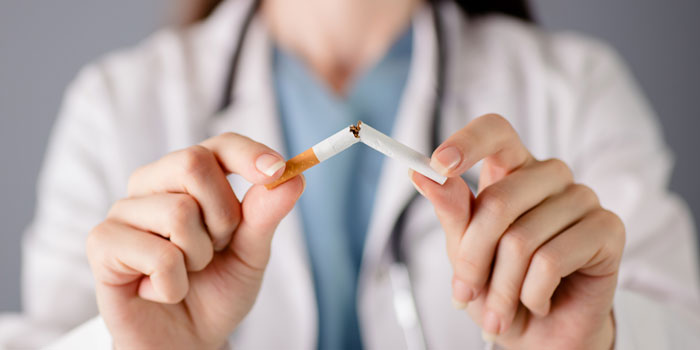
It may seem hard to believe, but in the early- and mid-1900s, many Americans believed smoking cigarettes was just as safe as chewing gum. After all, tobacco companies sent millions of free cigarettes to American service personnel in during WWII, and tobacco companies used doctors to market their products. One company boasted that “more doctors smoke” its brand than any other.
Thanks to plenty of continued research and a slew of public health awareness and educational efforts, we’ve come a long way in our understanding of the dangers of smoking. While cigarette smoking remains the leading cause of preventable disease and death in the United States—accounting for more than 1 in 5 deaths each year—the number of smokers has declined by two-thirds since 1964, when the U.S. Surgeon General first warned against its dangers. In fact, cigarette smoking among U.S. adults reached an all-time low of 13.7 percent in 2018.
Yet our understanding of why smoking causes cancer, especially in organs that are not located in the respiratory system, continues to evolve. In this article, we’ll explore the reasons behind smoking’s cancer risk, including:
- The health problems related to smoking
- How smoking causes cancer
- Cancer risk related to other types of tobacco products
- Tips to quit smoking
- Smoking cessation at CTCA
If you’ve been diagnosed with cancer and are interested in a second opinion about your diagnosis and treatment plan, call us or chat online with a member of our team.
The health problems related to smoking
Lung cancer is the third most common cancer in the United States and the leading cause of cancer deaths. More than 225,000 new lung cancer cases are diagnosed every year. But many mistakenly believe that smoking is only associated with lung disease and lung cancer. It’s a leading risk factor for many other types of cancer, including:
- Acute myeloid leukemia
- Bladder cancer
- Breast cancer
- Cervical cancer
- Colorectal cancer
- Esophageal cancer
- Kidney cancer
- Laryngeal cancer
- Liver cancer
- Oral and pharyngeal cancer
- Pancreatic cancer
- Stomach cancer
Tobacco use or exposure, which includes smoking, secondhand smoke or smokeless tobacco, also raises other health risks. It’s also one of the major causes of heart disease. Nicotine is a vasoconstrictor, meaning it causes the vessels to clamp down or contract, decreasing blood flow. Cigarette smoke also harms blood vessels and increases the chances of developing blood clots that sometimes lead to a heart attack or stroke. In addition, cigarette smoking:
- Damages the gums and promotes tooth decay
- May cause gastroesophageal reflux disease (GERD)
- Increases the risk of stroke
- Increases the risk of diabetes
- Causes chronic obstructive pulmonary disease (COPD), including emphysema and chronic bronchitis
- Is linked to Buerger’s disease, which causes swollen blood vessels, leading to blood clots, pain, tingling or burning in the extremities and gangrene, and sometimes requires amputation
How smoking causes cancer
Cigarettes contain many toxic chemicals. Some of these, such as nicotine and cadmium, come from the tobacco plant itself. Others are created when cigarettes are cured and manufactured. Still others, including benzene and carbon monoxide, form when you burn tobacco (as in lighting a cigarette). In total, smoking a cigarette releases about 7,000 chemicals—70 or so of which are linked to cancer.
Inhaling cigarette smoke sucks these chemicals into the mouth or nose and down the windpipe. Scientists found the first evidence explaining why smoking increases cancer risk in the 1960s, when they discovered that these chemicals can bind to the DNA of cells they come in contact with, damaging the cells’ DNA and causing mutations. The more DNA is damaged, the greater the risk that one or more cell mutations will develop into cancer.
Chemicals in the tar residue left behind in the lungs after smoking may also damage the organs, encouraging tumor growth and making it harder for the lungs to expand and contract. Smoking damages the alveoli, the small balloons-like sacs in the lungs, where the oxygen-carbon dioxide exchange occurs. Over time, the damaged alveoli may be able to expand, but are unable to contract. Your alveoli should be like a new balloon, very difficult to blow up initially, but after blowing the balloon multiple times, the tension on the balloon decreases, which makes it easier to blow.
Also, chemicals in smoke may damage the lining of the lung and cilia, which are fine hairs that clear the lungs by sweeping out mucus and fine dirt particles. The combination of an inability to contract the alveoli fully and the damage to the cilia prevents clearing of mucus, which may lead to a persistent “smokers cough.” Also, tar and other chemicals cannot be cleared out from the alveoli and airway, causing ongoing damage to the tissue.
The human body is designed to deal with some damage. We all have cells that have the potential to become cancer. The immune system is equipped to identify most of these threats and neutralize them. That’s why smoking-related cancer risk is directly linked to how much you smoke—and for how long.
“The immune system takes care of getting rid of foreign cells, recognizing that they’re not supposed to be there,” says Peter Baik, DO, FACOS, FACS, Thoracic Surgeon at CTCA in Phoenix and Chicago. “However, once those foreign cells are able to get away from the correctional efforts of the immune system and they start to grow uncontrollably. When that happens, it becomes invasive cancer. And that’s why chronic exposure to dangerous chemicals raises the risk that one of those cells will grow into cancer.”
Smoking is also the leading cause of cancer of the bladder, an organ far outside the respiratory system. According to the National Institutes of Health, more than half of all bladder cancers are caused by smoking. And smokers are twice as likely to develop bladder cancer than non-smokers. Chemicals in tobacco smoke eventually make their way into the bloodstream and urine, which is stored in the bladder.
Still, the chemicals in cigarette smoke aren’t the only way smoking increases cancer risk. Smoking also causes inflammation in the body. Chronic inflammation is linked to several health problems, including heart disease, Alzheimer’s and COPD.
It also doesn’t help that nicotine, while not cancer-causing itself, is extremely addictive, releasing the powerful chemical dopamine into the body’s nervous system, which is why smokers have a hard time quitting. Recent research has also found other harmful effects of the naturally occurring chemical found in tobacco, including its ability to:
- Speed up cell growth
- Serve as a catalyst that may lead to cancer cell growth
- Decrease the tumor suppressor CHK2, one of the body’s natural defenses against cancer
- Decrease the effectiveness of cancer treatment

Cancer risk related to other types of tobacco products
Pipe and cigar smoke is just as harmful as cigarette smoke, according to research, although the risk may be less because people who smoke pipes and cigars tend to smoke less frequently—and inhale less deeply—than cigarette smokers.
Cigar smoke contains many of the same cancer-causing chemicals as cigarette smoke, but often in higher concentrations. Large cigars can take one to two hours to smoke, causing increased exposure to toxic chemicals. And even if you don’t inhale while smoking a cigar, your mouth, throat and lips are exposed to cancer-causing chemicals, as is your esophagus when you swallow the saliva that contains the chemicals.
While cigar smokers typically have lower rates of lung cancer compared to cigarette smokers, they have a higher risk than nonsmokers.
Vaping, or e-cigarettes, may not contain tobacco, but many contain nicotine, which comes from tobacco, as well as harmful chemicals, such as diacetyl, formaldehyde and other volatile, organic, cancer-causing compounds found in cigarette smoke. They’re just present in lower amounts. Yet when they’re heated, these chemicals are released into the body with the same potential to cause damage. Because there are no testing requirements for e-cigarettes, there’s no way to know how safe these products are and what chemicals they may contain. Note that the FDA hasn’t approved e-cigarettes as a smoking-cessation method because their long-term effects aren’t yet known. Also, many vape liquids contain additives that may not be regulated or known to users. Researchers haven’t yet been able to definitively say whether smoking marijuana raises the risk of lung cancer, but they note that people generally inhale marijuana smoke more deeply and hold it in longer than people do when smoking cigarettes. That extended exposure gives toxins a better chance to stick to the lungs.
“Cigar and marijuana smoking and vaping—these can all cause an increased risk of cancer because there’s an increased exposure to these cancer-causing chemicals,” Dr. Baik says. “One doesn’t necessarily cause a greater cancer risk than another. It depends on the amount of exposure and what’s in the ingredients.”
An important way to prevent lung and other types of cancer is to avoid all smoking, including marijuana and tobacco products like cigarettes, cigars, pipes and e-cigarettes.
Tips to quit smoking
The health benefits when you stop smoking are numerous and well-documented:- Three to nine months after quitting, former smokers find their lung function improves by as much as 10 percent.
- After one year, their risk of heart attack decreases to about half that of a smoker.
- After 10 years, their risk of death from lung cancer is half that of a smoker.
- After 15, their heart attack risk is about the same as that of a never-smoker.
- Still, just as well-documented as the benefits of quitting is how hard it is to successfully quit. According to the Office of the Surgeon General, nearly 70 percent of smokers say they want to quit, and, each year, more than 50 percent say they try (yet most fail).

If you’re among those who want to quit, try these tips:
Make a plan
The first step to quit smoking is to decide to quit. Write down the reasons you want to quit and put your list in a place where you can see it every day, so it can help motivate you. Then, choose a day when you’ll stop. Tell a friend or family member the date you choose to help you with accountability.
Get medicinal help
The U.S. Food and Drug Administration (FDA) has approved seven types of medicine to help people quit smoking. Three—gum, patches and lozenges—are available over the counter. Four are available by prescription: inhalers, nasal sprays, antidepressants and a drug that blocks nicotine’s effects on the brain.
Combine medicine with counseling
Each state and Washington, D.C., has a telephone quit line available so people can call to talk to a trained counselor. You can also seek counseling help from a doctor, pharmacist or other health care provider, or find a support group in your area.
Use online resources
The National Cancer Institute (NCI) quit-smoking app, quitSTART, sends tailored tips, inspiration and challenges—and offers options to have supportive text messages sent to you. You can also visit the NCI’s Smokefree.gov site, which has tools and tips you can use to help quit.
Smoking cessation at CTCA
Many patients continue to smoke even after they’ve been diagnosed with cancer. In fact, some patients may smoke even more after their diagnosis as they deal with increased stress and anxiety.
Patients who choose to get treatment at CTCA are encouraged to quit smoking, even if it’s not believed to be the cause of their cancer.
At their initial visit with a CTCA Intake Care Physician, patients may be offered multiple options to help quitting, including:
Nicotine replacements: A doctor or counselor may recommend patches, gums or lozenges.
Medications: Some patients may be prescribed smoking cessation drugs such as varenicline (Chantix®) or bupropion (Wellbutrin®).
Behavioral health: Counseling to support patients’ emotional needs and mental health may be available to CTCA patients when appropriate.
Respiratory therapy: Patients may be offered the option to meet with a respiratory therapist to discuss coping techniques and behavioral modifications.
Support groups: Patients are often referred to national or local organizations that offer counseling, advice and products to help quit smoking.
It’s important for cancer patients to maintain or improve their overall health to help better navigate the potential rigors of cancer treatments, including by eating a healthy diet, getting exercise and quitting smoking.
“It's often very difficult to get patients to say they're ready to quit,” says Betti Grab, MHA, RRT-ACCS, Manager of Cardiopulmonary Services at CTCA Phoenix. “Quitting is so difficult. Most people fail several times before quitting successfully. And some patients tell us they're not interested in quitting. But we do try to encourage them and stress how important it is for their treatment, for their lungs and their health.”
If you’ve been diagnosed with cancer and would like to learn more about our treatment options at CTCA, or if you’re interested in a second opinion about your cancer diagnosis and treatment plan, call us or chat online with a member of our team.

